Seizing Opportunities in Non Audio-Centric Environments
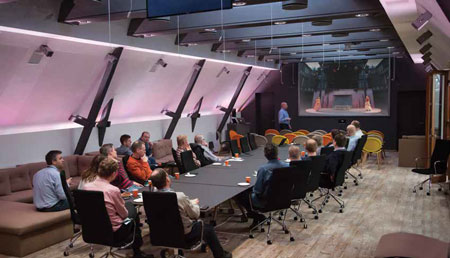
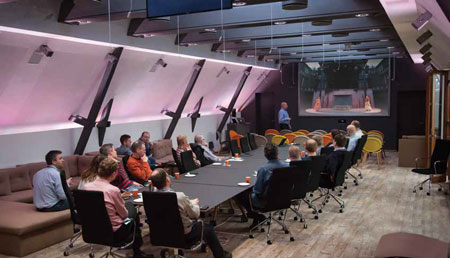
(Inset) John McMahon, vice president of solutions and strategy at Meyer Sound Laboratories in Berkeley, CA, argues that one of the reasons acoustics have often been neglected in non “audio-centric” environments is because there hasn’t existed a tool set to address them. Shown above is a solution from Meyer at the Jyske Bank. When Julian Treasure declared “it’s time to start designing for our ears,” the acoustical community nodded its collective head. “We’re designing environments that make us crazy,” he said in his 2012 TED Talk, ‘Why Architects Need to Use Their Ears.’ “And it’s not just our quality of life which suffers; it’s our health, our social behavior, and our productivity as well.”
Any AV integrator who has been called in to “fix” a meeting space that was designed explicitly for communication—but where participants can’t hear each other—would, or at least should, agree. Too often in boardrooms, classrooms, and restaurants, the design emphasizes aesthetics and sexy technology (think big, sleek displays), without considering acoustics. As a result, office staff is distracted by the workday noise around them, students have a hard time hearing their teachers, and restaurant patrons can’t have a decent conversation with the person who’s sitting across the table.

John McMahon, vice president of solutions and strategy at Meyer Sound Laboratories in Berkeley, CA, argues that one of the reasons acoustics have often been neglected in non “audio-centric” environments like these is because there hasn’t existed a tool set to address them. “The traditional solution has been to just dampen the room—make it dead with acoustic absorption,” he said. “That has a positive benefit in that it can reduce the noise level, but the negative of that is that it can make it like a library, where you can hear everyone else’s conversation because it’s so quiet. That can be somewhat disturbing, so making a room dead isn’t really the solution.”

Todd Berger, CET, CTS-D, field sales engineer at Cambridge Sound Management Inc. Among Meyer Sound’s offerings are the Libra Acoustic Image System, passive acoustic absorption available in either standard or custom size panels, and Constellation, which consists of loudspeakers, microphones, and digital processing, all working in combination to adapt to the architectural nuances of a specific space. The solutions are designed to work in tandem.
While having the right tools is one thing, getting them in front of the right people is another. McMahon acknowledges that for AV integrators, this can be an issue. “They are often connected with the IT or AV department inside a company, or a school, or wherever it might be, and acoustics are really more often dealt with from an architecture and infrastructure perspective,” he said. The trick is to connect with the people who not only make the architectural decisions, but also those who will understand the benefits of good acoustics as they relate to business case. “[You have to communicate] the value that you’re providing so that they’re able to understand that this treatment that you’re going to put on the walls and these components that you’re going to install are not just something that’s going to cost them a lot of money. You really have to be able to provide the benefit to them in terms of increased productivity, or in terms of students being more attentive, and being able to hear everyone in class.”
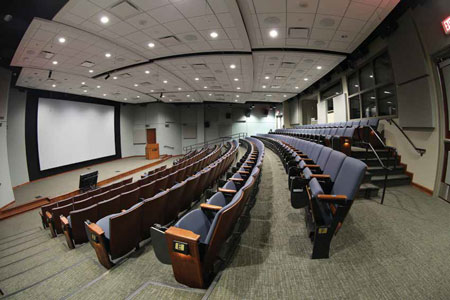
Among Meyer Sound’s offerings are the Libra Acoustic Image System, passive acoustic absorption available in either standard or custom size panels, and Constellation, which consists of loudspeakers, microphones, and digital processing, all working in combination to adapt to the architectural nuances of a specific space. The solutions are designed to work in tandem.
One way to get this point across is through demonstrations, noted James Wright, business development for Canada at Primacoustic in Port Coquitlam, BC. He points to before-and-after videos the company filmed for its Room Kit acoustic systems as an example. In any case, he emphasizes that clients need to be taught that traditional audio gear won’t help in poor acoustical environments. “You can’t fight physics. If the room sounds bad—if there’s echo in the room—no amount of DSP, no amount of speaker coverage is ever going to make up for that,” he said. “Getting the room sounding good is going to make the equipment you put in perform to its rated specifications.”
A daily selection of the top stories for AV integrators, resellers and consultants. Sign up below.
While good acoustics address the issue of enabling people to hear each other, they also need to allow for privacy in environments where not every inhabitant of a space should be privy to what’s going on behind closed doors—especially when there are no doors to close. “There’s a lack of speech privacy [with] today’s modern construction techniques, typically due to the lack of barriers, the assembly construction techniques we use, and the types of finishes now found in offices,” said Todd Berger, field sales engineer at Cambridge Sound Management, a sound masking systems developer based in Waltham, MA. Open offices may be hip and collaborative, but in many cases, they’re not suited for sensitive one-on-ones.
And it’s not just aesthetically minded hipsters that are creating acoustical problems for themselves. Berger noted that the demand for more energy-efficient spaces can also cause issues related to how sound travels. “Energy efficiency in many corporate offices is often the driving factor toward lower speech privacy,” he said. Lower partitions may allow organizations to benefit from daylighting, but acoustic isolation is compromised. “Even in instances where standard stud-and-gypsum techniques are used, wall assemblies often do not extend up to the deck, but rather stop just above the finished ceiling.” And that’s when there is a finished ceiling to work with; the industrial aesthetic favored in many of those hip open offices leaves many ceilings unfinished, decreasing acoustic absorption.
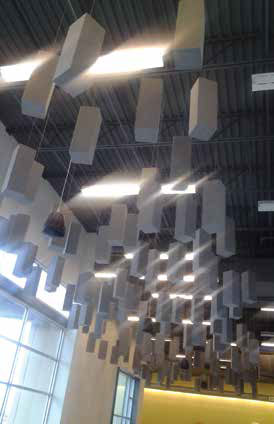
James Wright at Primacoustic emphasizes that clients need to be taught that traditional audio gear won’t help in poor acoustical environments. Primacoustics offers lantern acoustic technology to help with this. “You can’t fight physics. If the room sounds bad––if there’s echo in the room––no amount of DSP, no amount of speaker coverage is ever going to make up for that,” he said. “Getting the room sounding good is going to make the equipment you put in perform to its rated specifications.”
Cambridge Sound recently released two new sound-masking systems to address privacy issues in the corporate environment (the Qt Conference Room Edition), and in healthcare facilities (the Qt Patient Privacy System). Both are standalone systems comprised of a control module, two lit privacy signs, and a series of direct-field sound-masking emitters. “When we approach an end user regarding a sound-masking system, [we] ask if there is [somewhere] in the facility where acoustic privacy is a concern, such as human resources, [areas where there are] medical records, or an accounting department, for instance,” Berger explains. It also pays to ask clients if their employees have complained about being distracted by each other’s conversations. “What typically transpires from that conversation is that the need [for sound masking] does exist in many locations, but the client does not know that the solution is [out] there, or that the issue can be easily addressed.” He says that by asking the right questions, AV integrators stand to add these solutions to the packages they are developing for their customers.
While selling acoustics requires AV integrators to invest time in educating their customers, McMahon believes that awareness is on the rise. “Going back 10 or 15 years, you’d say the word ‘acoustics’ and people would stare at you with a strange look,” he said. “There’s more articles about acoustics in traditional places like The New Yorker [which last year ran an article by Alex Ross, “Wizards of Sound,” featuring Meyer Sound’s Helen and John Meyer] and The New York Times, and now restaurants have a loudness rating on a lot of review sites, and so there is a general increase in at least the knowledge that acoustics exist.”
Carolyn Heinze is a freelance writer/editor.
To Absorb or to Mask?
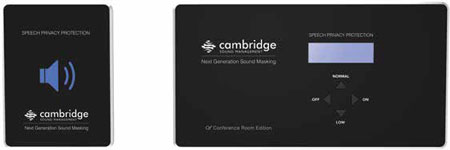
Cambridge Sound recently released two new sound-masking systems to address privacy issues in the corporate environment (the Qt Conference Room Edition), and in healthcare facilities (the Qt Patient Privacy System). Different spaces have different acoustical issues, requiring AV integrators to be well-versed in some basics. “For example, sound masking solutions are effective in making [private] conversations less intelligible in an open office environment, but would not be appropriate for the all-too-commonplace noisy restaurant environment, which often requires more acoustic absorption to control the reverberant sound energy,” said Todd Berger, field sales engineer at Cambridge Sound Management. “The different acoustic principles can oftentimes get confused by clients, and by building contractors, and even by design professionals. It’s important that the solution being sold is one that addresses the core problem, and [that] the integrator do their homework in order to provide the right solution.”
––C.H.
Carolyn Heinze has covered everything from AV/IT and business to cowboys and cowgirls ... and the horses they love. She was the Paris contributing editor for the pan-European site Running in Heels, providing news and views on fashion, culture, and the arts for her column, “France in Your Pants.” She has also contributed critiques of foreign cinema and French politics for the politico-literary site, The New Vulgate.
